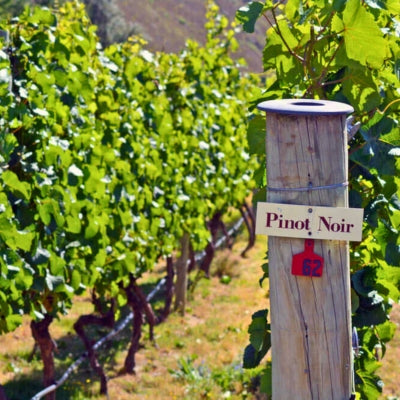
Grape school: Pinot Noir
Pinot Noir is one of the most internationally revered and challenging to grow grape varieties. Known for its elegance, complexity, and versatility, this red grape has been a favorite among wine enthusiasts for centuries. Originating from Burgundy, Pinot Noir is now cultivated in many of the world's premier wine regions, from Oregon to New Zealand, California to Australia.
Origins and history
Historical records trace the origins of Pinot Noir in Burgundy back to the 4th century, making it one of the oldest cultivated grape varieties.
The name "Pinot" is derived from the French word for “pine”, referring to the grape's tightly clustered, pinecone-shaped bunches, while the word “Noir” is the French word for “black”.
Over the centuries, Burgundy has become synonymous with some of the finest expressions of Pinot Noir, particularly in the Côte d'Or. The grape's journey beyond France began in the 19th and 20th centuries, finding new homes in diverse climates around the globe, such as America, New Zealand, and Australia, each imparting unique characteristics to the wine.
Appearance and growing conditions
Pinot Noir grapes are small and thin-skinned, with a deep purple hue. The vine thrives in cooler climates, where it can develop complex flavors and maintain balanced acidity. Pinot Noir is notoriously difficult to cultivate, requiring specific conditions to flourish, including well-drained soils and a long, steady growing season.
The grape's sensitivity to climate and soil variations makes it highly expressive of its terroir. In cooler climates, Pinot Noir tends to produce wines with bright acidity and delicate fruit flavors, while warmer regions can yield riper, more robust expressions.
Despite its finicky nature, the grape's ability to reflect its growing environment is one of its greatest strengths, leading to a wide range of styles.
Flavor profile
Pinot Noir is celebrated for its aromatic complexity and nuanced flavor profile. Common tasting notes include red fruits like cherry, raspberry, and strawberry, often complemented by floral aromas such as rose and violet. Earthy undertones, including forest floor, mushroom, and truffle, add depth and intrigue to the wine.
The grape's thin skin results in relatively low tannins, giving Pinot Noir a smooth, silky texture. Aging can introduce secondary flavors like vanilla, clove, and smoke, especially when matured in French oak. The best examples of Pinot Noir express a balance of fruit, acidity, and earthiness, creating a harmonious and elegant wine that evolves beautifully with age.
Food pairings
Pinot Noir's versatility and balanced structure make it an excellent companion to a wide variety of foods. Its bright acidity and red fruit flavors pair well with lighter fare, such as roasted chicken, pork tenderloin, and salmon. The wine's earthy notes complement dishes featuring mushrooms, truffles, and root vegetables.
Pinot Noir also pairs beautifully with various cheeses, from soft, creamy varieties like Brie and Camembert to more robust options like Gruyère and aged Cheddar. Its subtlety allows it to enhance, rather than overpower the flavors of delicate dishes, making it perfect for food pairing.
Notable producers
France remains the benchmark for high-quality Pinot Noir, particularly in Burgundy, with legendary producers like Domaine de la Romanée-Conti, Domaine Ponsot, and Domaine Dujac leading the way.
In the New World, California's Sonoma Coast and Russian River Valley are renowned for their exceptional Pinot Noirs, with producers such as Kistler and Kosta Brown gaining acclaim. Oregon's Willamette Valley has emerged as a premier region for Pinot Noir, with wineries like Domain Nicholas-Jay, Domaine Serene, and Beaux Frères producing outstanding wines.
New Zealand's Central Otago, situated on the southern 45th parallel, and Martinborough are also noted for their distinctive, high-quality Pinot Noirs, with producers like Felton Road and Ata Rangi making significant contributions to the grape's global reputation.
Australia’s cool climate region Tasmania is known for producers like Tolpuddle, which utilizes low intervention and traditional practices, producing concentrated Pinot Noir wines.
Conclusion
Pinot Noir's elegance, complexity, and expressive nature have secured its place as one of the world's most cherished grape varieties. From the ethereal, refined wines of Burgundy to the vibrant, fruit-forward expressions from California and beyond, its sensitivity to terroir and ability to produce both delicate and powerful wines make Pinot Noir a favorite in the wine world.
Want to read more? Take a look at some of our other blogs:



